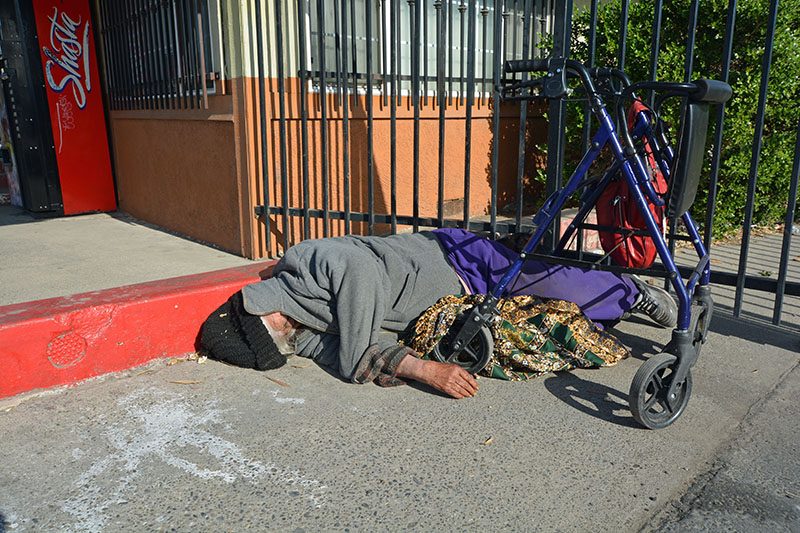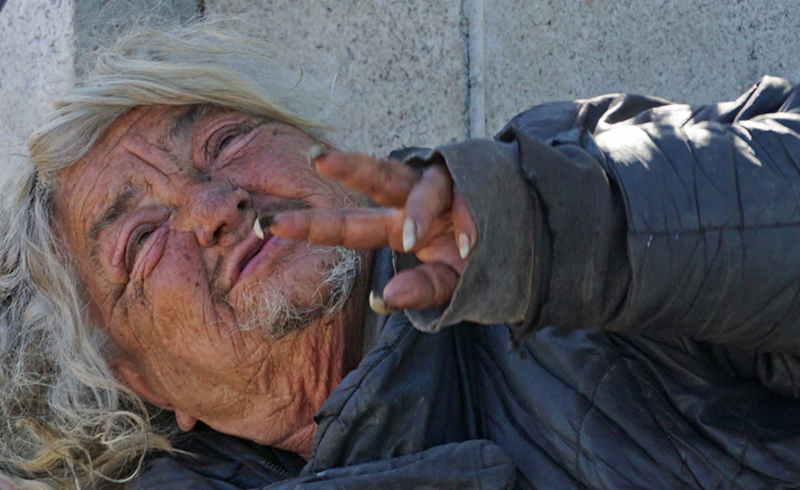We’re no longer stunned or dismayed. We’ve become so habituated to California’s vast sprawl of homelessness that encampments along the freeways, bodies on the sidewalks. and human debris everywhere arouse no more concern than a speed bump or fire hydrant. The objectification of human beings in distress has become a norm for almost all of us. Homeless people have become inanimate parts of the daily landscape.
Ronald Reagan began what became a long period of mischaracterization over forty years ago, when he said of homeless people, “…one problem that we’ve had, even in the best of times, and that is the people who are sleeping on the grates, the homeless who are homeless, you might say, by choice.”
Reagan knew better. As Governor of California from 1967 to 1975, he had presided over reduced funding for mental institutions. As President of the United States, he pushed for repeal of the Mental Health Systems Act (MHSA), which provided money for community mental health systems of care and social support services.
Over the years since the Reagan administrations, homeless numbers have waxed and waned. One consistent trend has been the high numbers of mentally ill among California’s homeless population — the people who came into the streets when funding dried up for services while housing prices skyrocketed.
In 2023, a study of homelessness by the University of California at San Francisco found that,
“82% of people experiencing homelessness said they had a mental health condition or substance use challenge in their lifetime. And 66% said they were currently experiencing mental health problems, such as depression, anxiety, hallucinations, or trouble remembering things.”

By definition, mentally ill people are sick, and, most often, incapable of consistent rational behavior. Many suffer from anosognosia, a condition that prevents them from recognizing they are ill. Blaming homelessness on people who “choose” to be homeless when they are mentally ill is like blaming a passenger for driving the bus into a ditch. Nonetheless, homeless people are routinely characterized as “choosing” homelessness.
In a similar vein, drugs are commonly cited as the “cause” of homelessness, despite contrary evidence. Per capita drug use in several states is much higher than in California and homelessness in those states is much lower; those same states have far fewer housing shortages and lower rents than California.
Disabled people in California often receive under a thousand dollars a month. Rents throughout the state are much higher, even for a single room in a motel. A significant percentage of homeless people are physically disabled and trying to live on disability incomes. Those low incomes keep them out of housing of any kind.
Courts have ruled that inhumane laws and ordinances for homeless people amount to “cruel and unusual” punishment for obvious reasons. Punishing the sick and disabled by refusing them even a place to lie down and rest is a clear violation of the most fundamental rule of humanity: “Do unto others as you would have them do unto you.”
Nonetheless, throughout the state, including Valley cities like Fresno, Modesto and Turlock, sweeps of homeless camps and isolated campers are routine. In Modesto, anyone sleeping in a park or on public space of any kind will likely be forced to move along. Elderly, disabled, mentally ill — it doesn’t matter.
Given the number of studies that show large percentages of the homeless population are mentally or physically ill, disabled, elderly or traumatized, most would agree that penalizing these people for “crimes of existence” like sleeping is cruel. Nonetheless, sweeps and rousts remain California’s most common tactic for managing homelessness throughout the state.
Cruelty to any living thing is a transgression against nature. Cruelty to human beings is an especially pernicious sin because humanity — the better part of human nature — is always precarious and endangered. When we punish the ill and disabled by denying them a place to rest or sleep, we set civilization on a reverse path toward cruel indifference.
Homelessness is a humanitarian crisis not only because it subjects the ill and infirm to dire stress and unrelenting punishment, but also because it enables casual and indifferent cruelty through habituation and objectification. We’ve gotten so used to human suffering we no longer comprehend it, even when it’s directly in front of our eyes.


Where is the ‘canary in the coal mine’ to alert us habituated people back to moral awareness? I’ve often thought that was the province of religion and other morality keepers. Have we passed the point of no return and are destined to next let the homeless suffer even more by denying even basics such as food and clothing? When you hear talk of banning feeding it sure seems that way. Wake up Modesto!! Wake up California!
Americans need to sympathize with the less fortunate and help where we can. I totally agree with your article and shame on our government for not doing more to help and make sure every American has a place to lay their heads. Thank you for caring and writing this article. I hope more will be done to help the homeless.
A problem so complex that even condensed it would take 10,000 comments that would fit in this box to convey just a portion of the problems and possible band-aids.
Well, good article, but blaming a dead guy for this , vs. ignoring the living Politicians who have used this subject to get rich – including California’s Governor is also interesting. Government can’t solve this problem alone, and if you look up all the Tax dollars spent on homelessness in California alone, you would be agast . this year’s State Budget has $9 Billion to deal with this. Over the past 20 years, California has spent upwards of $30 Billion. This doesn’t count the $$ spent by cities and countiees- I suspect over $50 billion has been spent and the problem is getting worse, not better. So, as one comment says- our government should do more- so, maybe throw a Trillion or two at the problem(and thus raise income taxes to about 100%)? Or, maybe there is another solution out there. working with non profits and yes, returning to mental institutions with some oversight might be an answer too.
Damon and other Valley readers:
It is easy to write about what should be done by whom.
Better yet, is to act to help our currently 400+ still left out in our streets and riverbanks.
For example, contact SHARE and contribute to SHARE’s continuing life-saving work with our unsheltered.
SHARE: https://www.facebook.com/sharestanislaus/ 993-4984
Damon, he wasn’t blaming a dead guy though that person didn’t help a bit and made bad, worse.. The real problem is solutions by those not really familiar with the subject,.
Humans lost in this situation and no visible way out they think. So a committee is formed and dollars spent. There doesn’t seem to be a willingness to test out the different solutions. It’s this or nothing it seems. So all the DETAILS get lost in the furor of accomplishment and the subject is ended. Some do get helped but not the majority because it really isn’t just one problem such as homelessness. That is just the result of lots of things. It won’t be really helped until someone is willing to say, I need to find out ALL the problems that lead to this state and then try to solve them as we find them. All the problems, jobs, lack of education, high living prices, mental issues drug and alcohol usage and the list might be even longer as I definitely don’t know them all. The community around them have to be flexible enough to learn what that is, be that Federal, State. County, city or rural village. Some diseases or problems need more than one solution to fix the whole problem. Why should one this big be just one fix, like a roof?
I have a brother who is homeless. And it’s heartbreaking not knowing how he is or where he is. I tried helping him out many times….but the truth is I didn’t have the knowledge or know anything about mental illness at that time. The ” just get clean and get a job” attitude doesn’t help. I like your writing style, very clear and with facts to back it up. My husband also had siblings who were homeless here in Modesto and died a horrible death. There is such a stigma around family and homeless. We need to realize that these persons you see on the streets hungry, cold and dirty are somebody’s baby boy or little girl, that they are someone’s brother or sister, family member, childhood friend. We need to start seeing them as just more than an inconvenience.
thanks for all the thoughts. And, to be clear, I have a grandson who is homeless. He is 23 and attending college, but likely facing homelessness for years to come. His parents are still fighting in court after 13 years of divorce, with one younger son left, and thus too busy to care about their oldest son who is struggling with substance abuse issues and the seemingly inability to have gainful employment. Yes, it is frustrating. I have helped to fund my grandson, but i have to be careful not to directly give him $$, less he use it on substances… I also know of many others who are in and out of being homeless- there is no simple solution. I have a nephew who volunteers at a homeless shelter in New York- where they seek individual solutions as there is no single solution to each person’s reason for being homeless- this takes a lot of time and effort- and it is likely the best solution to helping people get back to having a home.
YES, NOT ONE SIZE FITS ALL, BUT TAILOR MADE
HOUSING FIRST, IS IN ACCORD WITH ABAHAM MASLOW’s BASIC NEEDS. ONCE HOUSED, HAVING MET THAT GOAL, PEERS CAN AVAIL THEMSELVES TO SUPPORT THEM TOWARD OTHER NECESSITIES THAT CAN THEN BE FOCUSED ON, ONCE STABILIZED INSIDE, NOT DEMANDED OF WHILE ON THE STREETS.
IT IS NOT ROCKET SCIENCE, IT IS LOGIC
IN THE MEAN TIME, AND, THESE ARE MEAN TIMES, IT IS LOGICAL TO DESIGN SAFE CAMPING GROUNDS. ROUSTING, SWEEPING, OR WHATEVER NAME IT GETS DESCRIBED AS, IS ILLOGICAL.
ITS AKIN TO PAINTING SMOKESTACKS ON THE TITANIC AS IT GOES DOWN… LUDICROUS WASTE OF ACTIVITY CARRIED OUT TO PLEASE WHOM???
THE MENTAL HOSPITALS WERE LONG AGO EMPTIED OF TORTURED HUMAN BEINGS, ONTO THE STREETS, CERTAINLY NOT TO DO THEM A GOOD DEED, APPARENTLY. THEY ARE STILL BEING TORTURED. AKIN TO BEING PUSHED FROM THE FRYING PAN INTO THE FIRE.
THE COUNTY OF STANISLAUS ALLOWED THE SAME TO HAPPEN TO THE NATIVE AMERICANS IN THESE LANDS. THE CITY OF MODESTO HAS LEARNED NO LESSON. SHE ALLOWS THE DEFENDERS OF THE CITY TO STILL CALL THE SHOTS. OPEN SEASON ON THE MARGINALIZED. WOULD A LITERAL CULLING BE PROPOSED IF THEY COULD? DO THEY TALK OF SUCH BEHIND CLOSED DOORS? THE PLUNDERERS? THE PRIVATEERS?